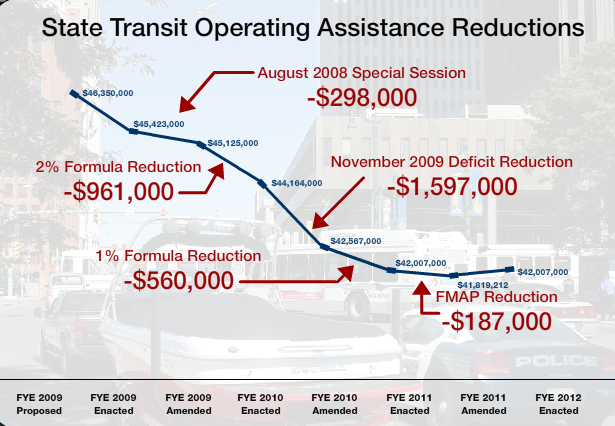
Yesterday, the commissioners of the Niagara Frontier Transportation Authority (NFTA) formally adopted a plan to cut 22% of service miles from their Metro transit system.
These cuts attempt to address NFTA’s $15 million budget shortfall, which stems from increased operating costs and reduced funding from Albany (money that’s known as State Operating Assistance, or STOA). Since 2009, Buffalo has seen a $3.6 million reduction in STOA and a $7 million increase in operating costs, and they’re not the only transit system in the state that’s suffered from these cutbacks.
NFTA, like many transit systems, isn’t scaling back service because people aren’t taking the bus. With 27 million annual passengers and over 1,600 employees, it’s the second largest transit provider in the state. Approximately 84% of metro riders use the system to get to work, and 77% of these don’t own a car. As a coalition of advocates noted last week, this means that these cuts “will undermine all other efforts to spur economic development in our region—even if we create jobs, people won’t be able to get to them.”
Faced with this hard reality—an economically vital transit system that can’t make ends meet—NFTA has requested $10 million from Albany during the 2012-13 fiscal year. They also requested eight megawatts of low-cost power from the New York Power Authority, which would provide $1.8 million in annual operating savings. Buffalo officials have been joined by Erie County and New York State legislators in their calls for help from Governor Cuomo. TSTC and several other advocacy organizations have joined this fight.
The situation is dire. Unless NFTA gets more funding, it will have few choices beyond cutting routes and raising fares. Across New York, transportation authorities are implementing cost saving measures, but they can only fasten their belts so much before they cut off circulation entirely.
To help NFTA and other New York transit agencies stay alive, demand that Albany stand up for transit.

NFTA should have a .25 preferrable .50% sales tax dedicated as revenue in Erie & Niagara County. Then metro riders hopefully wouldn’t be subject to this annual manufactured political crisis. If not raise the fares to fill the revenue gap.
[…] transit systems get attention: upstate bus systems have long struggled to deliver service. Bus systems currently receive revenue from the petroleum business tax, which […]
[…] transit systems get attention: upstate bus systems have long struggled to deliver service. Bus systems currently receive revenue from the petroleum business tax, which […]
[…] affected by service changes and fare hikes. The bill, which came after public outcry concerning proposed cuts to transit service in western New York, has also passed the […]
[…] Authority (NFTA), which serves Buffalo and the surrounding region. After a tumultuous year spent grappling with fare hikes and service cuts, the transit authority took an important step by proposing this bill, which will ensure that riders […]
[…] a much-needed boost in their operating funds, and helped to stem some troubling service cuts, particularly in Buffalo, and prevented deeper cuts in Nassau County. The state needs to permanently redistribute this tax […]